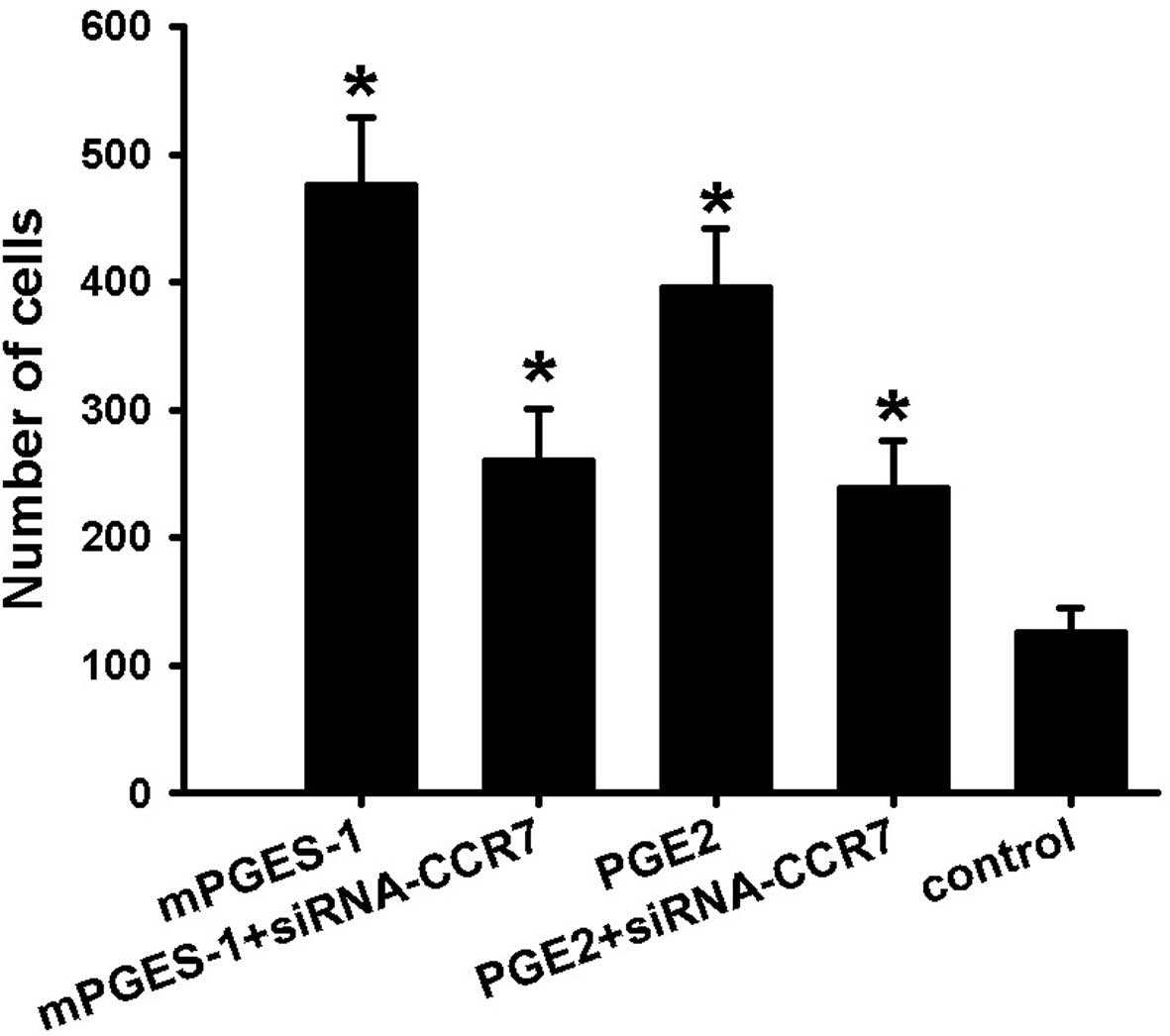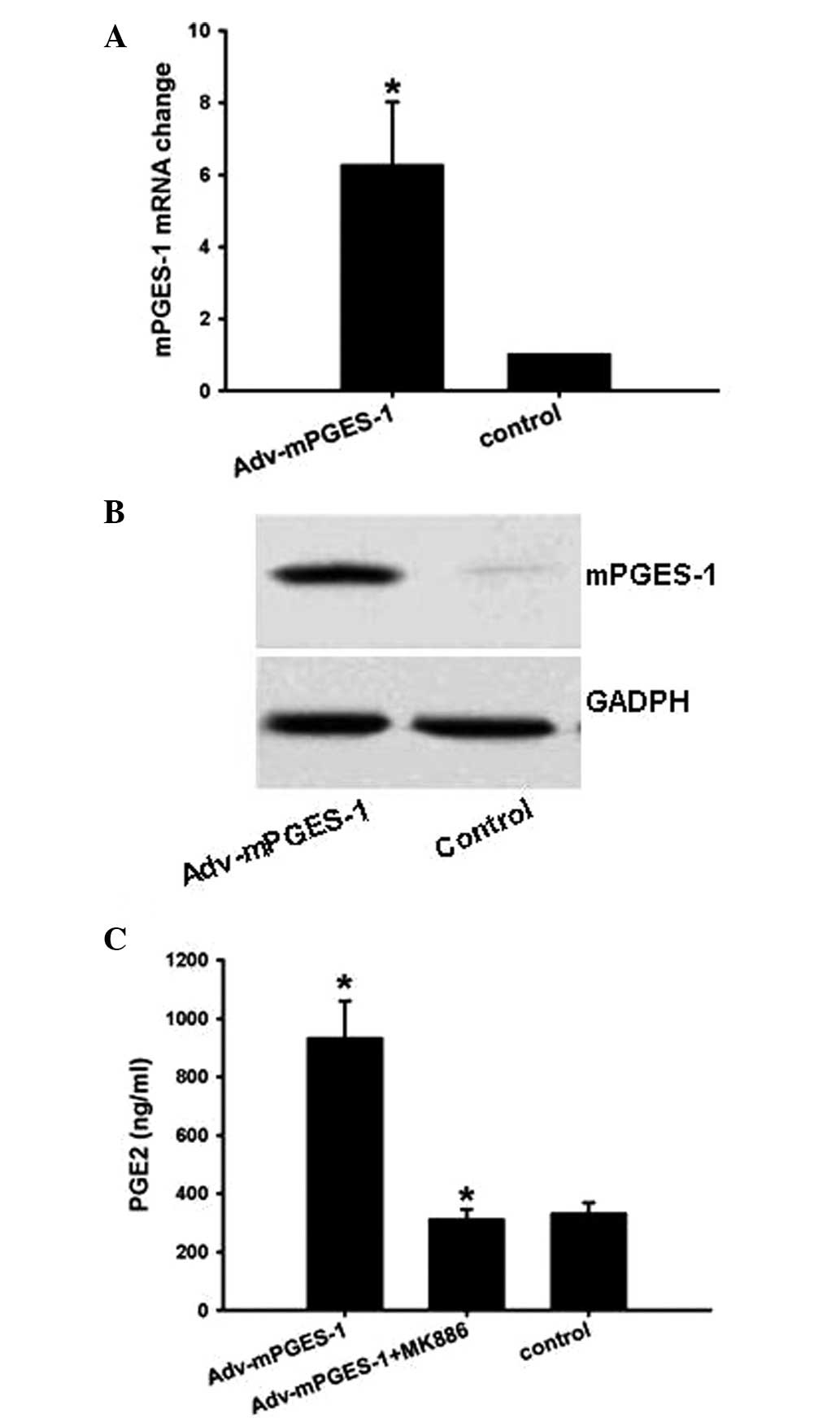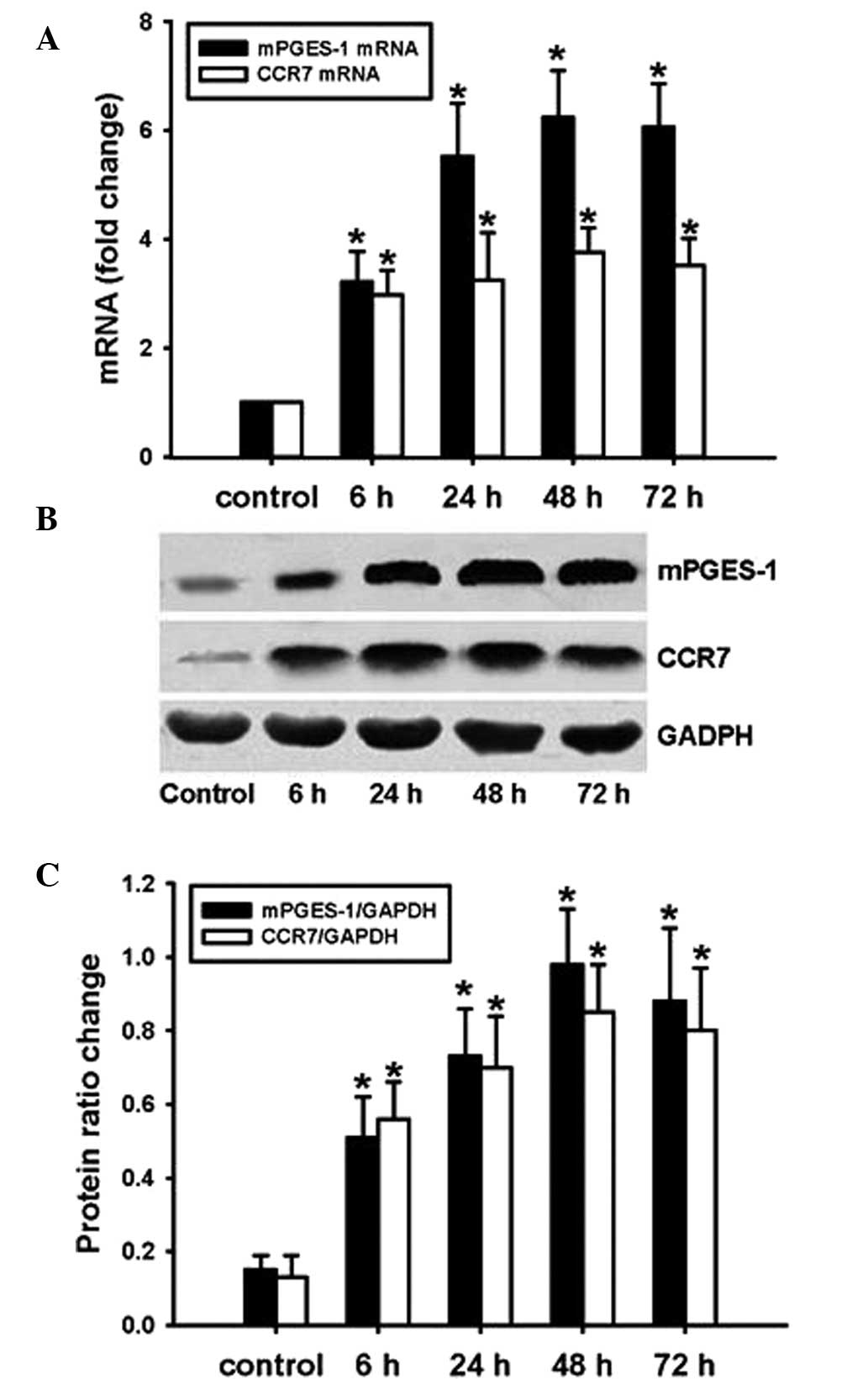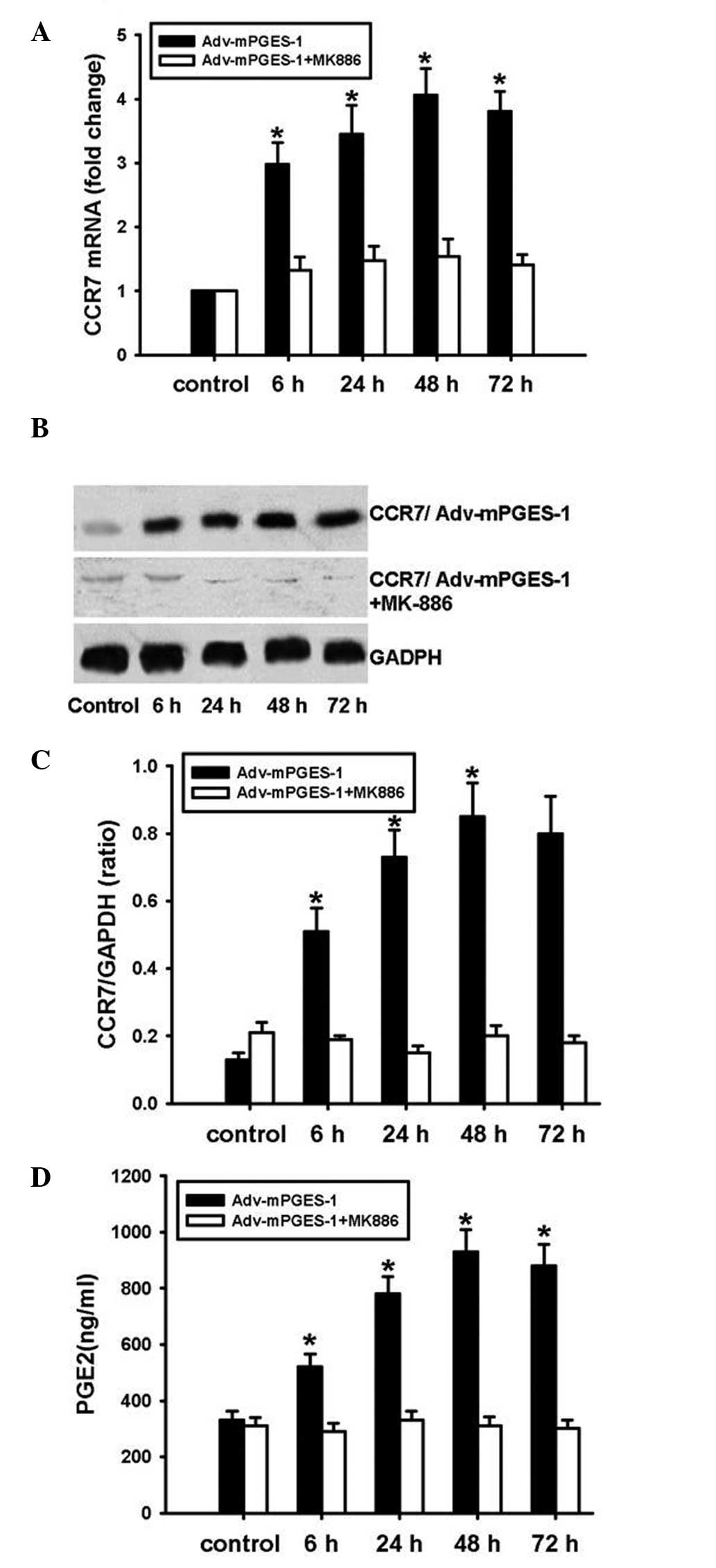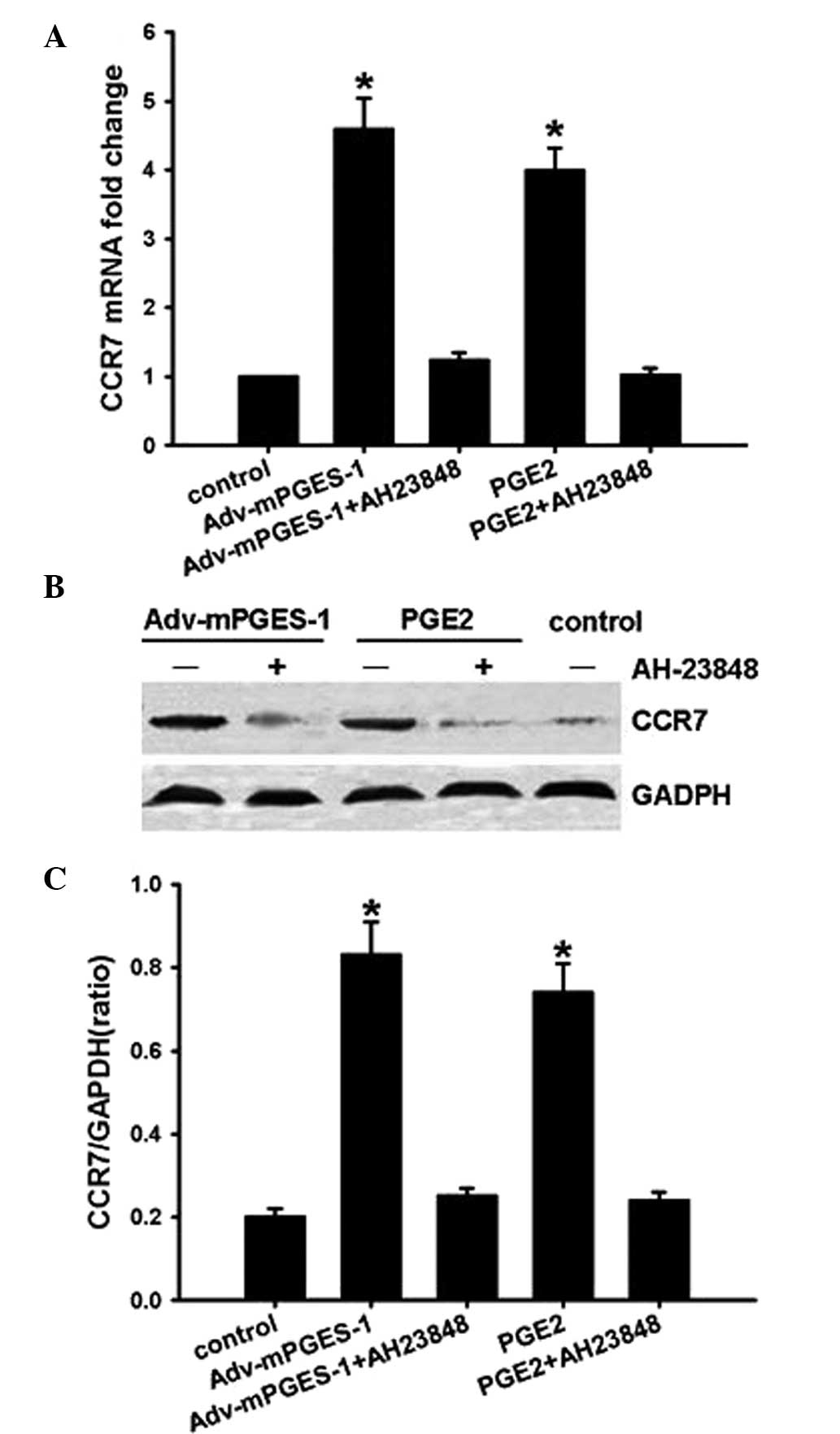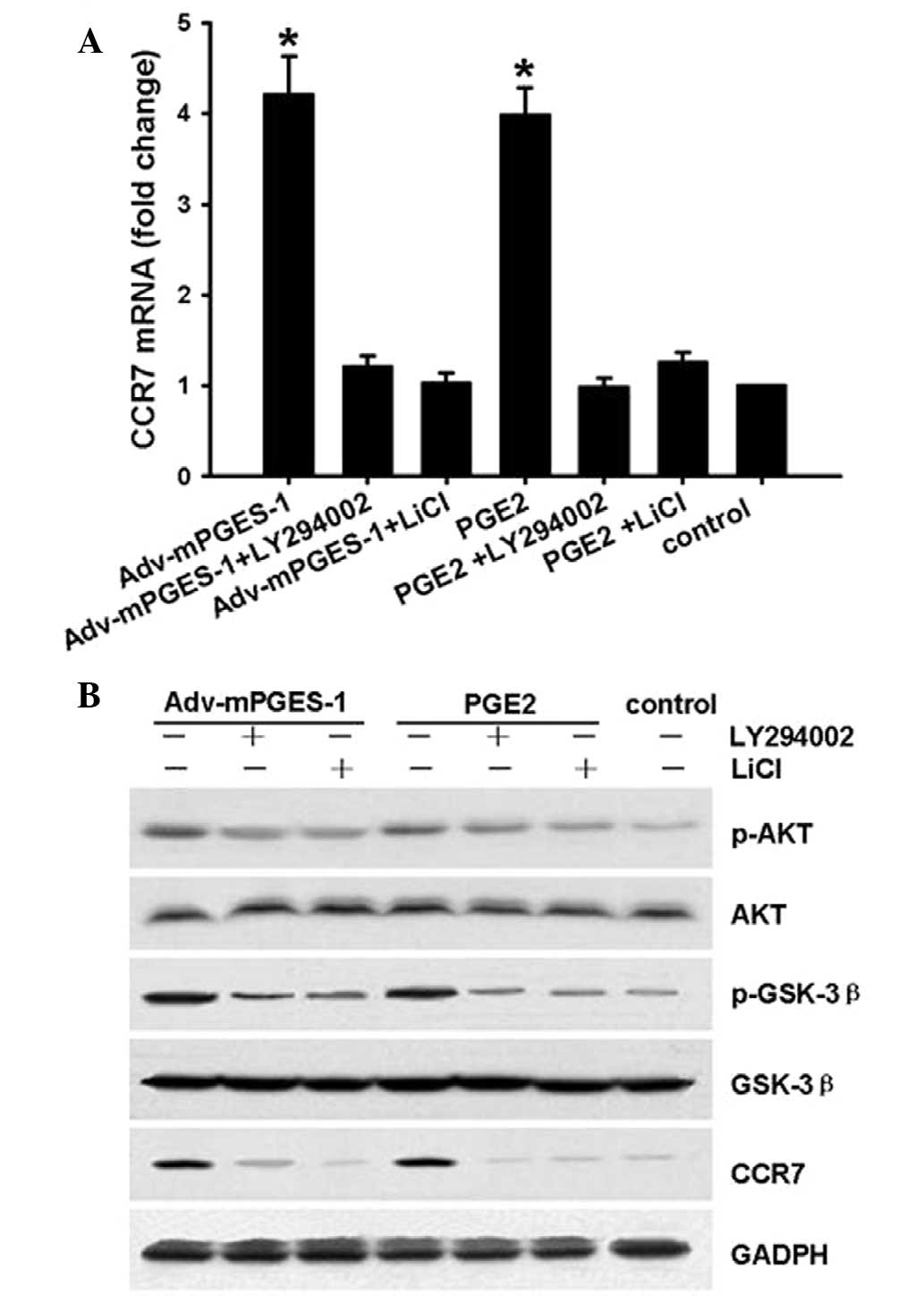Upregulation of C-C chemokine receptor type 7 expression by membrane-associated prostaglandin E synthase-1/prostaglandin E2 requires glycogen synthase kinase 3β-mediated signal transduction in colon cancer cells
- Authors:
- Published online on: September 3, 2015 https://doi.org/10.3892/mmr.2015.4290
- Pages: 7169-7175
Abstract
Introduction
Growing evidence has indicated that the tumor microenvironment is largely regulated by orchestrated signaling of chemokines and pro-inflammatory cytokines, which are produced by inflammatory and cancer cells, and contribute to cancer progression (1). The complex interactions between the chemokine C-C chemokine receptor type 7 (CCR7) and the inflammatory cytokinesmembrane-associated prostaglandin E synthase 1 (mPGES-1)/PGE2 were the subject of the present study.
CCR7 was reported to be a homing receptor regulating the migration of immune cells to secondary lymphoid organs in response to C-C ligand 21/secondary lymphoid organ chemokine (2). Müller et al (3) also observed this mechanism in CCR7-expressing cancer cells, which was associated with the establishment of lymph node metastasis. Accumulating evidence indicated that CCR7 is overexpressed in numerous cancer types and is positively correlated with cancer metastasis and survival (4,5). Previous studies by our group demonstrated that CCR7 was frequently overexpressed in human colon cancer and breast cancer tissues and was associated with poor prognosis (6,7). Another study by our group showed that CCR7 expression is regulated by cyclooxygenase (COX)-2/PGE2 through prostaglandin EP4 receptor in colon as well as in breast cancer cells (8). In this process, inducible COX-2 and mPGES-1, which are frequently upregulated in numerous cancer types, cooperatively synthesize PGE2, which contributes to carcinogenesis and cancer progress (9,10). These findings implied that overexpression of CCR7 in cancer cells may proceed via mPGES-1/PGE2.
mPGES-1 is the terminal synthase responsible for the synthesis of the most abundant pro-tumorigenic prostaglandin, PGE2, which has a large number of biological actions via four types of receptors, EP1-4. mPGES-1 is mainly an induced isomerase, is overexpressed in a wide variety of cancer tissues and cells, and mediates numerous critical processes involved in tumor progression, including oncogene activation, DNA damage and tumor metastasis (11). Although the pathological implications of CCR7 and mPGES-1 have been revealed in a large variety of malignant tumors, the role of mPGES-1 in CCR7 expression in colon cancer as well as the underlying molecular mechanisms have remained elusive. The present study investigated the role of mPGES-1 in the induction of CCR7 expression as well as the possible involvement of the EP4 receptor in SW620 colon cancer cells. The involvement of the phosphoinositide-3 kinase (PI3K)/AKT/glycogen synthase (GSK)-3β signaling pathway was also investigated.
Materials and methods
Chemicals and reagents
mPGES-1 recombinant protease was purchased from USCN Life Sciences (Wuhan, China). PGE2, PGE2 ELISA kit, PI3K inhibitor LY293002, EP4 inhibitor AH-23848 and GSK-3β inhibitor lithium (LiCl) were obtained from Cayman Chemical (Ann Arbor, MI, USA). Rabbit anti-human, monoclonal primary antibodies against phosphorylated (p)-GSK-3β (cat. no. 9315L), p-Akt (Ser473; cat. no. 9271L), Akt (cat. no. 9088S), CCR7 (cat. no. 9412S) and GADPH (cat. no. 9022L) were obtained from Cell Signaling Technology, Inc. (Shanghai, China). Rabbit anti-human polyclonal primary antibody against mPGES-1 (cat. no. 160140-1) were obtained from Cayman Chemical. The plasmid pDC104 and the small interfering (si)RNA-expressing pUC19-green fluorescence protein (GFP)-siRNA-CCR7 vector (siRNA-CCR7) were purchased from Qiagen China (Shanghai, China).
Cell culture
The SW620 colorectal carcinoma cell line was obtained from the Type Culture Collection of the Chinese Academy of Sciences (Shanghai, China). SW620 cells were maintained in RPMI 1640 culture medium (Gibco-BRL, Invitrogen Life Technologies, Inc., Carlsbad, CA, USA) supplemented with 10% fetal bovine serum (FBS; Gibco-BRL, Invitrogen Life Technologies) under a humidified 5% CO2 atmosphere at 37°C in an incubator. In the present study, the cells were harvested after treatment with PGE2 or transfection with mPGES-1 Adv for 48 h. To further examine the signal transduction, cells were treated with LY293002 (10 µmol/l), LiCl (10 µmol/l) or AH23848 (10 µmol/l) 2 h prior to administration of PGE2 (10 µmol/l) or transfection with mPGES-1 Adv.
siRNA transfection
One day prior to transfection, SW620 cells were trypsinized and 3×105 cells were seeded into six-well plates. Transient transfection of the pUC19-GFP-siRNA-CCR7 vector was performed using Lipofectamine 2000 (Takara Bio Inc., Dalian, China) in serum-reduced medium according to the manufacturer's instructions. Cells were subjected to assays 48 h after transfection.
Construction of recombinant adenovirus (Adv) encoding human mPGES-1
The recombinant replication-defective Adv expressing full-length human mPGES-1 (Adv-mPGES-1) was constructed by two-plasmid rescue methods as previously described (12). Human full-length mPGES-1 cDNA was isolated and cloned into the EcoRI site of shuttle plasmid pDC104 (Qiagen), and its sequence was confirmed. The sequence was confirmed by DNA Sequencers HiSeq 2000 (Illumina, Inc., San Diego, CA, USA) and a Genomic DNA Sample Prep kit (cat. no. FC-102-1001, Illumina, Inc.). The purified shuttle plasmid was combined with rescue plasmid pBHGlox-delE1/E3.cre2 (Qiagen) and co-transfected into 293 cells (Type Culture Collection of the Chinese Academy of Sciences) to rescue the Adv (12). Large-scale virus production was performed by infection of 293T cells for 72 h. The cells were maintained at −20°C for 15 min and 37°C for 15 min three times, centrifuged (2,500 × g, 10 min, 4°C), then viruses were collected from cell lysates by cesium chloride gradient ultracentrifugation (100,000 × g, 90 min, 4°C; Cayman Chemical) and viral titers were detected using a plaque assay. mPGES-1 transgene expression of Adv-mPGES-1-infected SW620 cells was confirmed by reverse-transcription quantitative polymerase chain reaction (RT-qPCR) and western blot analysis.
Transwell migration assay
A chemotaxis assay was performed in 24-well Millicell cell culture inserts (Millipore Corp., Billerica, MA, USA) with 8-µm pore membranes. SW620 cells transfected with adenovirus (Adv)-mPGES-1, siRNA-CCR7 or treated with PGE2 (10 µmol/l, 24 h) were suspended in RPMI 1640 at 2×104/ml and added to the upper chamber. In parallel, SW620 cells treated with mPGES-1 protein or PGE2 were suspended in RPMI 1640 at 2×104/ml and added to the upper chamber. 600 µl medium containing 10% FBS was added to the lower chamber and served as a chemotactic agent. After incubation for 24 h, cells which had migrated to the lower surface of the membrane were stained with hematoxylin and eosin (Beijing Solarbio Science & Technology Co., Ltd., Beijing, China) and counted under a light microscope (IX83; Olympus, Tokyo, Japan) in five fields of view at a magnification of ×400. Results were expressed as the mean number of migrated cells/well in experiments performed in triplicate.
RT-qPCR
Total RNA was isolated using TRIzol reagent (RNA Extraction kit; cat no. 15596-026; Invitrogen Life Technologies, Inc.) according to the manufacturer's instructions. cDNA was synthesized from 500 ng total RNA using the SuperScript™ III First-Strand Synthesis System (cat no. 18080-051; Invitrogen Life Technologies, Inc.) according to the manufacturer's instructions. Real-time PCR was performed in a 20-µl reaction mixture containing 1 µl cDNA, 10 µl 2X SYBRH Premix Ex Taq™ (cat no. DRR420A; Takara Bio Inc.) and 300 nM of each paired primer using the following thermocycling conditions: 35 cycles of 94°C for 3 min, 94°C for 30 sec, 62°C for 30 sec, 72°C for 10 sec and 72°C for 2 min. Quantification of target and reference (GAPDH) genes was performed in triplicate using an ABI7500 real-time fluorescent quantitative PCR system (Applied Biosystems, Thermo Fisher Scientific, Waltham, MA, USA). The primers used in each reaction were as follows: CCR7 forward, 5′-GGT GGT GGC TCT CCT TGT CAT TTT C3′ and reverse, 5′-AGT AGG CCC ACG AAA CAA ATG ATG G3′; mPGES-1 forward, 5′-TGC TCA GCC ACC ATCT GGA GTTTTA3′ and reverse, 5′-TTC CAC CAT ACA GGA ACC CAA GACC3′; GAPDH forward, 5′-GCA CCG TCA AGG CTG AGA AC-3′ and reverse, 5′-TGGTGAAGACGCCAGTGGA-3′. After normalization to GAPDH, expression levels for each target gene were calculated using the comparative threshold cycle (CT) method using ABI 7500 software v2.0.1 (Applied Biosystems). The ΔCt values were calculated according to the formula ΔCt = Ct (gene of interest) - Ct (GAPDH) in the correlation analysis. The mRNA levels of the control group were used as the baseline, and ΔΔCt was calculated using the formula ΔΔCt = ΔCt (target gene) - Ct (baseline). The fold change of mRNA levels was calculated as fold = 2−ΔΔCt.
Determination of PGE2 levels by ELISA
Approximately 2×106 SW620 cells were cultured in 60-mm dishes for 15 h. One group of cells was pre-incubated with MK886 for 1 h (10 µmol/l, Cayman Chemical); cells were then transfected with Adv-mPGES-1 vector for 0–48 h. The culture medium was centrifuged at 14,000 × g for 10 min at 4°C. The supernatant was collected and stored at −80°C until analysis. PGE2 levels were measured using a Prostaglandin E2 Enzyme Immunoassay kit (cat no. 500141; Cayman Chemical) according to the manufacturer's instructions. Absorbance values were determined using a Microplate Reader (model 550; Bio-Rad Laboratories, Inc., Hercules, CA, USA).
Western blot analysis
Cells were lysed in lysis buffer (25 mmol/l Tris-HCl, 300 mmol/l NaCl, 1 mmol/l CaCl2, 1% Triton X-100, pH 7.4; Invitrogen Life Technologies, Inc.) containing protease inhibitor (Complete Mini; Roche Diagnostics, Basel, Switzerland). Whole-cell lysates were centrifuged at 10,000 ×g for 20 min and the supernatants were collected. The protein concentration was determined using the bicinchoninic acid-based Protein Assay kit (Pierce Biotechnology, Inc., Rockford, IL., USA). Proteins (30–50 µg per sample) were separated using 10% SDS-PAGE (Roche Diagnostics) and transferred onto polyvinylidene difluoride membranes (Roche Diagnostics). After being blocked with 5% milk powder in Tris-buffered saline containing Tween 20 (TBST) for 1 h at room temperature, the membranes were incubated with the primary antibody and β-actin at 4°C overnight, followed by incubation with the corresponding horseradish peroxidase-conjugated secondary antibody at room temperature for 1 h. Detection was performed using an enhanced chemiluminescence kit according to the manufacturer's instructions and the protein bands were visualized after exposure of the membranes to Kodak X-ray film. The results were normalized to GAPDH expression. E-Gel® Imager Software (Thermo Fisher Scientific) was used for grey value analysis of the bands.
Statistical analysis
Values are expressed as the mean ± standard deviation of three independent experiments unless otherwise specified. Statistical analysis of data was performed using a two-tailed unpaired Student's t-test between any two groups. One-way analysis of variance was used to assess difference between mean values among groups. SPSS 10.0 (SPSS, Inc., Chicago, IL, USA) was used for all statistical analyses. P<0.05 was considered to indicate a statistically significant difference between values.
Results
mPGES-1/PGE2 mediated migration of SW620 cells is partly blocked by siRNA-CCR7
Migration and invasion are among the hallmarks of tumor cells and are correlated with their aggressiveness and patient prognosis. Tumor cells with an aggressive phenotype acquire migratory and invasive capabilities. This involves the upregulation of biochemical mechanisms which promote the dissemination of tumors cells to distant organs. The effects of mPGES-1/PGE2 on the migratory ability of SW620 cells was measured using a Transwell migration assay. As shown in Fig. 1, treatment of cells with mPGES-1 recombinant protease or PGE2 (1 µM) for 48 h resulted in a significant increase in cell migration, and compared with the control, the number of migrated cells increased by ~4-fold, which was significantly inhibited by siRNA-mediated knockout of CCR7. However, in the groups in which CCR7 knockout was performed, treatment with mPGES-1 or PGE2 increased the number of migrated cells by 2-fold compared with that in the control group. As the enhancement of the migratory ability by mPGES-1 or PGE2 was partly blocked by siRNA-CCR7, it is indicated that mPGES-1 and PGE2 contribute to the migration of SW620 cells and that CCR7 is crucial in mPGES-1/PGE2-mediated migration of SW620 cells.
Detection of Adv-mPGES-1 vector efficiency
As PGE2-mediated cell migration was partly blocked by siRNA-CCR7, the present study next constructed the overexpression vector Adv-mPGES-1, which was used to investigate whether CCR7 expression can be upregulated by mPGES-1-derived PGE2. The results showed that Adv-mPGES-1 vector enhanced mPGES-1 mRNA and protein levels (Fig. 2A and B), which was most efficient following transfection with the vector for 48 h (data not shown). Following transfection with Adv-mPGES-1 vector, PGE2 secretion in the cell culture supernatant was markedly enhanced by 3-fold, which, however, was conpletely blocked by mPGES-1 inhibitor MK886 (Fig. 2C).
mPGES-1/PGE2 promotes CCR7 expression in SW620 cells
SW620 cells were transfected with Adv-mPGES-1 vector for 6, 24, 48 or 72 h and mRNA expression of mPGES-1 and CCR7 was assessed by RT-qPCR. PGE2 levels in the cell culture supernatant were determined by ELISA. The results showed that after transfection with Adv-mPGES-1 vector, expression of mPGES-1 and CCR7 mRNA was markedly enhanced (Fig. 3A). Similarly to the trends in mRNA expression, the protein expression of mPGES-1 and CCR7 was markedly increased following forced overexpression of mPGES-1 (Fig. 3B and C). At the mRNA as well as the protein level, transfection time-dependent changes in CCR7 expression were in parallel with those of mPGES-1. To further examine the association of mPGES-1 and CCR7 expression in SW620 cells, mPGES-1 inhibitor MK886 was employed. Pre-treatment of SW620 cells with MK886 prior to transfection with Adv-mPGES-1 blocked the transfection-mediated increases in PGE2 release and CCR7 expression at the mRNA as well as the protein level (Fig. 4A–D). These results indicated that for the mRNA and the subsequent protein expression of CCR7, PGE2 derived from mPGES-1 is required. It can be concluded that in SW620 cells, expression of mPGES-1 leads to increases in the levels of PGE2, which then stimulates the expression of CCR7.
mPGES-1/PGE2 mediates CCR7 expression via receptor EP4 and subsequent activation of the Akt-GSK3β pathway
A previous study by our group reported that COX2/PGE2 increased CCR7 expression via the EP4 receptor in cancer cells (8). Therefore, the present study used EP4 inhibitor AH-23848 to investigate whether the activation of EP4 is involved in the underlying molecular mechanisms of the mediation of CCR7 expression by mPGES-1/PGE2. SW620 cells were pre-treated with the inhibitor for 1 h prior to transfection with Adv-mPGES-1 vector or treatment with PGE2 (10 µM) for 48 h. RT-qPCR and western blot analysis of CCR7 showed that the EP4 inhibitor completely blocked mPGES-1/PGE2-mediated CCR7 expression at the mRNA as well as at the protein level (Fig. 5), implying that mPGES-1/PGE2 enhanced CCR7 expression through binding with receptor EP4.
GSK3β is a kinase located downstream of the PI3K/AKT pathway. GSK3β maintains an active state in its de-phosphorylated form. The present study determined whether the mediation of CCR7 expression by mPGES-1/PGE2 involves the Akt-GSK3β pathway in SW620 cells. For this, SW620 cells were treated with PI3K/AKT inhibitor LY294002 (20 µM) or GSK-3β inhibitor LiCl (20 µM) for 1 h prior to mPGES-1/PGE2 treatment, following which CCR7, p-AKT and p-GSK3β levels were assessed by RT-qPCR or western blotting. The results showed that after transfection with Adv-mPGES-1 vector or treatment with PGE2 (1 µM) for 8 h, in parallel with changes in CCR7 expression (Fig. 6A), the levels of p-AKT and p-GSK3β increased, while the levels of AKT and GSK-3β were not affected (Fig. 6B). These results indicated that the EP4-PI3K/AKT-GSK3β pathway is involved in the enhancement of CCR7 expression by mPGES-1/PGE2 in SW620 cells.
Discussion
CCR7 is overexpressed in numerous cancer types and is involved in the occurrence, progression, metastasis and invasion of cancer (1–5). Thus, identifying targetable components of signaling pathways that regulate CCR7 expression may have broad therapeutic implications. Previous studies by our group have demonstrated that in colon cancer cells and tissues, COX-2/PGE2 enhanced the expression of chemokine CCR7 through the EP4 receptor, which contributed to cancer proliferation and metastasis (6–8). mPGES-1 signals downstream of COX-2 and, as the last key enzyme of the PGE2 synthesis pathway, contributes to the synthesis and secretion of PGE2 in cooperation with COX-2. Previous studies, including those using mPGES-1-knockout mice, indicated key roles of mPGES-1-generated PGE2 in female reproduction and in pathological conditions, including inflammation, pain, fever, anorexia, atherosclerosis, stroke and tumorigenesis (13,14).
In the present study, the link between CCR7 and mPGES-1 was investigated. The results suggested that PGE2 secretion was markedly enhanced by overexpression mPGES-1, and that CCR7 expression in colon cancer cells was significantly upregulated following overexpression mPGES-1 or treatment with PGE2. These increases, however, were blocked by mPGES-1 inhibitor MK886. It is implied that CCR7 expression is upregulated by mPGES-1-derived PGE2 in colon cancer cells, which is consistent with previous studies by our group reporting that COX-2 and mPGES-1 promoted cancer progression (6,7). These studies indicated that in colon cells, CCR7 expression is upregulated by COX-2 and mPGES-1; however, their influence on cancer progression requires further investigation. Another study by our group and a previous study indicated that mPGES-1-derived PGE2 enhanced CCR7 expression through binding to the EP4 receptor (8). Similarly to the findings by our group, the COX-2/mPGES-1/EP-4 axis has been indicated to be involved in the proliferation, migration and angiogenesis of human tenocytes and cancer cells as well as to be implicated in human abdominal aortic aneurysm (15,16). By contrast, other studies showed that COX-2 and mPGES-1-derived PGE2 promoted cancer progression through the EP2 receptor in canine and feline malignant mammary tumors (17,18). These studies indicated that there cell type- and species-dependent differences may exist, possibly due to different biological functions of mPGES-1-derived PGE2 through binding to different receptors.
GSK-3β is a multi-functional serine/threonine protein kinase located downstream of the PI3K/AKT pathway, which has a variety of regulatory activities and participates in numerous signaling pathways. It has a regulatory role in the genesis and progression of a variety of malignant tumor types through regulating cancer-associated processes, including proliferation and apoptosis (19,20). GSK3β maintains an active state in its de-phosphorylated form. The present study determined that Akt-GSK3β signal transduction was involved in the enhancement of CC7 expression by mPGES-1 through PGE2 binding to the EP4 receptor. Thus, in addition to inhibiting mPGES-1 expression in cancer cells, EP4 antagonists and AKT/GSK-3β inhibitors may emerge as potential therapeutics to reduce CCR7 expression in cancer. It is likely that CCR7 has a crucial role in mPGES-1/PGE2-mediated cancer-cell migration. The underlying mechanisms of the interaction of mPGES-1 and CCR7 in cancer-cell migration and the resulting formation of metastases deserves further investigation.
Acknowledgments
The present study was supported by the Nation Natural Science Foundation of China (grant nos. 81101476 and 81460613) and the Guangxi Nature Science Foundation of China (grant no. 2013GXNSFBA019126 to J.L.).
References
|
Coffelt SB and de Visser KE: Cancer: Inflammation lights the way to metastasis. Nature. 507:48–49. 2014. View Article : Google Scholar : PubMed/NCBI | |
|
Lipp M, Burgstahler R, Müller G, Pevzner V, Kremmer E, Wolf E and Förster R: Functional organization of secondary lymphoid organs by the chemokine system. Curr Top Microbiol Immunol. 251:173–179. 2000.PubMed/NCBI | |
|
Müller A, Homey B, Soto H, Ge N, Catron D, Buchanan ME, McClanahan T, Murphy E, Yuan W, Wagner SN, et al: Involvement of chemokine receptors in breast cancer metastasis. Nature. 410:50–56. 2001. View Article : Google Scholar : PubMed/NCBI | |
|
Cowan JE, McCarthy NI, Parnell SM, White AJ, Bacon A, Serge A, Irla M, Lane PJ, Jenkinson EJ, Jenkinson WE and Anderson G: Differential requirement for CCR4 and CCR7 during the development of innate and adaptive αβT cells in the adult thymus. J Immunol. 193:1204–1212. 2014. View Article : Google Scholar : PubMed/NCBI | |
|
Reinhardt A, Ravens S, Fleige H, Haas JD, Oberdörfer L, Łyszkiewicz M, Förster R and Prinz I: CCR7-mediated migration in the thymus controls γδ T-cell development. Eur J Immunol. 44:1320–1329. 2014. View Article : Google Scholar : PubMed/NCBI | |
|
Yu S, Li J, Ji W and Chen Y: CCR7 expression is regulated by COX-2 in colon cancer cells. Chin J Mod Med. 21:5–9. 2011.In Chinese. | |
|
Yu S, Li J, Ji W and Chen Y: The clinicopathological features of COX2 and CCR7 in human breast carcinoma tissue. Chin J Mod Med. 21:990–992. 2011.In Chinese. | |
|
Yu S, Duan J, Zhou Z, Pang Q, Wuyang J, Liu T, He X, Xinfa L and Chen Y: CCR7 is a critical role in invasion and metastasis of colon cancer in vivo and in vitro. Cancer Biol Ther. 7:1037–1043. 2008. View Article : Google Scholar : PubMed/NCBI | |
|
Ruan D and So SP: Prostaglandin E2 produced by inducible COX-2 and mPGES-1 promoting cancer cell proliferation in vitro and in vivo. Life Sci. 116:43–50. 2014. View Article : Google Scholar : PubMed/NCBI | |
|
Casós K, Siguero L, Fernández-Figueras MT, León X, Sardá MP, Vila L and Camacho M: Tumor cells induce COX-2 and mPGES-1 expression in microvascular endothelial cells mainly by means of IL-1 receptor activation. Microvasc Res. 81:261–268. 2011. View Article : Google Scholar : PubMed/NCBI | |
|
Chang HH and Meuillet EJ: Identification and development of mPGES-1 inhibitors: Where we are at? Future Med Chem. 3:1909–1934. 2011. View Article : Google Scholar : PubMed/NCBI | |
|
Bett AJ, Haddara W, Prevec L and Graham FL: An efficient and flexible system for construction of adenovirus vectors with insertions or deletions in early regions 1 and 3. Proc Natl Acad Sci USA. 91:8802–8806. 1994. View Article : Google Scholar : PubMed/NCBI | |
|
Elander N, Ungerbäck J, Olsson H, Uematsu S, Akira S and Söderkvist P: Genetic deletion of mPGES-1 accelerates intestinal tumorigenesis in APC (Min/+) mice. Biochem Biophys Res Commun. 372:249–253. 2008. View Article : Google Scholar : PubMed/NCBI | |
|
Samuelsson B, Morgenstern R and Jakobsson PJ: Membrane prostaglandin E synthase-1: A novel therapeutic target. Pharmacol Rev. 59:207–224. 2007. View Article : Google Scholar : PubMed/NCBI | |
|
Ruan D and So SP: Prostaglandin E2 produced by inducible COX-2 and mPGES-1 promoting cancer cell proliferation in vitro and in vivo. Life Sci. 116:43–50. 2014. View Article : Google Scholar : PubMed/NCBI | |
|
Dolkart O, Liron T, Chechik O, Somjen D, Brosh T, Maman E and Gabet Y: Statins enhance rotator cuff healing by stimulating the COX2/PGE2/EP4 pathway: An in vivo and in vitro study. Am J Sports Med. 42:2869–2876. 2014. View Article : Google Scholar : PubMed/NCBI | |
|
Camacho M, Dilmé J, Solà-Villà D, Rodríguez C, Bellmunt S, Siguero L, Alcolea S, Romero JM, Escudero JR, Mar tínez-González J and Vila L: Microvascular COX-2/mPGES-1/EP-4 axis in human abdominal aortic aneurysm. J Lipid Res. 54:3506–3515. 2013. View Article : Google Scholar : PubMed/NCBI | |
|
Millanta F, Asproni P, Canale A, Citi S and Poli A: COX-2, mPGES-1 and EP2 receptor immunohistochemical expression in canine and feline malignant mammary tumours. Vet Comp Oncol. May 14–2014.Epub ahead of print. View Article : Google Scholar : PubMed/NCBI | |
|
Mai W, Miyashita K, Shakoori A, Zhang B, Yu ZW, Takahashi Y, Motoo Y, Kawakami K and Minamoto T: Detection of active fraction of glycogen synthase kinase 3beta in cancer cells by nonradioisotopic in vitro kinase assay. Oncology. 71:297–305. 2006. View Article : Google Scholar | |
|
Shakoori A, Ougolkov A, Yu ZW, Zhang B, Modarressi MH, Billadeau DD, Mai M, Takahashi Y and Minamoto T: Deregulated GSK3beta activity in colorectal cancer: Its association with tumor cell survival and proliferation. Biochem Biophys Res Commun. 334:1365–1373. 2005. View Article : Google Scholar : PubMed/NCBI |



